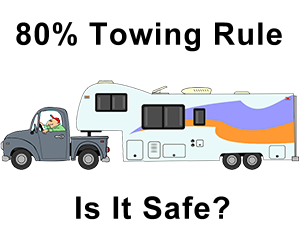
 Often, someone will suggest that a vehicle’s published tow rating should be 80% or 75% of the published towing capacity to provide a safe towing capacity margin. Some are teaching these rules at various RV safety seminars too.
Often, someone will suggest that a vehicle’s published tow rating should be 80% or 75% of the published towing capacity to provide a safe towing capacity margin. Some are teaching these rules at various RV safety seminars too.
Are these kinds of rules enough? Are they too much? Will these simple formulas keep someone within the manufacturer’s weight safety ratings?
Unfortunately, these simple rules do not consider every family’s size and additional cargo that may be carried (or attached equipment) in the tow vehicle. The weight of a tow-ready vehicle directly affects the realistic vehicle towing capacity (RVTC).
Let’s look at two scenarios to show how the 80% rule will not keep a tow vehicle from exceeding the weight safety ratings. This example shows the exact vehicle with two different families.
Test Vehicle
2017 Ford F250, Crew Cab, 4X2, Diesel, LWB
GCWR=28,700
GVWR=10,000
Curb Weight=7,104
Published 5th Wheel Towing=16,800
5th Wheel/Gooseneck Hitch Combo Weight=250
Family A
Two persons weighing 335 pounds
Additional cargo=100 pounds
Family B
Four persons weighing 565 pounds
Additional cargo=150 pounds
Using the simple rule of reducing the published tow rating by 20%, the alleged safe towing capacity margin is 13,440 pounds (16,800 X .8 = 13,440).
Now, let’s consider the family size and the gross vehicle weight (GVW). To accomplish this, the app found at RVtowCheck.com was used to develop the RVTC for a 5th wheel trailer having a 20% pin weight.
Family A: The RVTC is 11,055 pounds. (Difference: 2,385 pounds—80% margin not nearly enough)
Family B: The RVTC is 9,655 pounds. (Difference: 3,785 pounds—80% margin not nearly enough)
As you see above, the 80% rule fails badly. Even if the pin weight were calculated at 17% for family A and 15% for family B, the rule would have failed. These simple rules that have been freely tossed around do not always work. In fact, this rule could put a family at risk. It is possible that rules like this are part of the reason that 60% of all tow vehicles exceed their published weight safety ratings.
If a 2017 Ford F350 Crew Cab, 4X2, SRW, Diesel, SWB was used, the alleged 80% safe towing capacity margin is 16,800 pounds (21,000 X .8 = 16,800), then the RVTC would be as follows:
Family A: The RVTC is 17,910 pounds. (Difference: 1,110 pounds—80% margin too much)
Family B: The RVTC is 16,510 pounds. (Difference: 290 pounds—Pretty close to 80% margin)
Most of the major truck manufacturers are now using SAE J2807 as the standard for calculating GCWR and TWR, I don't think having a buffer is any longer necessary. With today's modern standards, I don't see any reason not to tow up to the calculated max allowable for a tow-ready vehicle. To learn more about SAE J2807, click here.
Friends, anytime someone suggests simple rules like these, take it with a big grain of salt. If a simple rule is not correct 100% of the time, it is worthless and may place you in a situation you may regret or prevent you from getting the dream trailer safe for you to tow.
Rather than sharing the unreliable and potentially unsafe rules, you could recommend using RV Tow Check to obtain an actual realistic vehicle towing capacity (RVTC).
©2011-2025 Fifth Wheel Street and Fifth Wheel St. All Rights Reserved. Use of this website constitutes acceptance of the Privacy Statement and Terms and Conditions of Use.